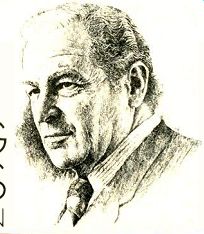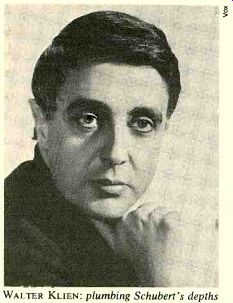
by IRVING Kolodin
SCHUBERT FOR PIANO OR PIANISTS
WHEN Frederic Chopin made his first appearance in Paris in 1832, one listener, more perceptive than others, defined him as a new phenomenon in the world of music by commenting that Beethoven composed "music for the piano" but Chopin composed "music for pianists." It is too bad that Francois Joseph Fitis did not have powers of divination as well as of judgment, for he would certainly then have said something also about the piano music of Franz Schubert, not yet as well known to Paris as he would be a few years later.
The distinction made between music for pianos and that for piano players is, for a change, a distinction with a difference, and Schubert's sonatas too, like those of Beethoven, were composed for the piano rather than for pianists. All too often, however--as in the instances of three current Schubert discs by Maurizio Pollini (the Wanderer Fantasy and the A Minor Sonata, D. 845, Deutsche Grammophon 2530 473), Deszd Ranki (the same Wanderer Fantasy and the G Major Sonata, D. 984, Hungaraton SLPX 11644), and Christoph Eschenbach (the B-flat Sonata, Op. Posth., D. 960, Deutsche Grammophon 2530 477)-a failure to grasp this difference is likely to intrude between the player and the music.
In all three instances noted (though with varying degrees of miscalculation), the approach is primarily pianistic and only secondarily musical. Each performer bases his claim to recognition on how he can perform as a pianist (how loud, how fast, how brilliant) rather than as a musician (how understanding, how eloquent, how imaginative). The problem is further complicated by the undeniable circumstance that the more ambitious and extended the works are, the more they demand mastery of matter, not of manner. What Schubert poured into the keyboard works of his later years was music of the same depth and variety as that of his best songs, his greatest chamber music, his finest symphonies. It just happened, in this case, to be written for the piano.
Of the three pianists mentioned above, Maurizio Pollini may very well be the best.
That he is a formidable technician is not least apparent in his playing of the works of Franz Liszt. He might, indeed, do very well by the version of the Wanderer Fantasy that Liszt made for solo piano and orchestra. But on this recording he must be concerned only with what Schubert confided of his purpose to the ...

----- WALTER KLIEN: plumbing Schubert's depths
... piano, and the results are both too much and too little. Pollini tends consistently to expand, extend, and enhance the output of piano sound, which is both more than is warranted by the music and less than is wanted by the listener, for mood, meaning, and substance are diminished by the overwhelming impact of sheer sound. The great A Minor Sonata is less pounded than the Fantasy, more cajoled--as it deserves; but the keen edge of virtuosity is not directed accurately enough to avoid cutting into defenseless flesh.
If Deszb Ranki, born in Hungary in 1951, were to depend wholly on his qualifications as a technician to get himself mentioned in the same breath with Pollini, he would hardly make it_ His Wanderer is, indeed, a little breathless and understated, the G Major Sonata being more within his present range of dynamic power and re-creative input. In both, nonetheless, there are evidences of that Schubertian lilt without which almost all other virtues of interpretation are insufficient. A very talented-and musical-pianist of Hungarian training, Ranki has a future that should be both guarded and well documented by Hungaraton.
Christoph Eschenbach might be described as a licensed mystic, one who tends by nature and disposition to take on the most sizable challenges of the composers to whose music he is attracted-he has, for example, record ed Beethoven's B-flat Hammerklavier Sonata and all the sonatas of Mozart. Schubert's late B-flat Sonata is almost as much a challenge, though in a different way, as Beethoven's massive work, slightly earlier, in the same key. Eschenbach responds to the music as though he regards it, in one sequence of measures, as Schubert's Waldstein and, in another, as perhaps his Moonlight. The B-flat Sonata may very well have had such a dual character for Schubert--it was, after all, his right as a creator to be a weathervane responding to the forces about him, now in one mood, now in another. But it is the function of the re-creator to absorb, digest, and reconstitute these impulses in such a way that the music becomes steadily more intelligible to the listener. This, to me, Eschenbach does not do in this exacting work.
AMONG today's pianists, Walter Klien of Vienna is one of the best situated, musically and intellectually, to act as such a translator of Schubert's impulses and inclinations. He has become, in the aftermath of Alfred Bren del's ascent to a higher order of activity (meaning, at the very least, the nicer album jackets provided by Philips), the Voice of the Vox Box. Klien's earlier identity (it is hard to ignore a man who spells his name "Klien" and not the more usual "Klein") was as an all-inclusive interpreter of Brahms, and he has since recorded all the solo-piano works of Mozart. Draw a vector between these two musical forces and the line-that of Viennese identity-might very well point directly to Schubert.
In my view, Klien's treatment of eighteen Schubert sonatas (recently issued in three-disc Vox Boxes 5465, 5466, and 5467) hardly contains enough musical substance for eighteen sides. Nor is the content as defensibly "complete" as the jacket labeling contends.
The notes themselves tell us, for instance, that Schubert wrote his "twenty-first and last" sonata (and even that phrase under states the number by one) in 1828, shortly be fore his death. There are repeated instances, however, of Schubert's failing to finish a work he had started. Vox has included as many of these as conveniently fit the eighteen-side formula, but they have omitted four others.
Weighed on the scale of musical merit, the sonatas' highest quality is concentrated in the last three great works, the several of inter mediate date (the highly potent G Major of 1826; the lovable A Minor, Op. 42, and the surpassingly fine D Major of 1825; and the quietly reflective A Minor, Op. 143, of 1823), with a choice, a piacere, of two or three of the six the composer began and finished in 1817-1819. That adds up to nine or ten, leaving a number of others as either tentative straws in the wind of the direction Schubert would later take, or promising efforts lacking one or more movements.
To be sure, if the earlier works have some what less interest for the listener, knowledge of them has certainly contributed to making Klien the formidable interpreter of all the Schubertian gambits he is today. They have provided him with an intimate awareness of the progression from work to work, beginning with those in which conformity to earlier models overshadows individuality, followed by those in which the elements are in total balance, and on to the extraordinary half-dozen in which individuality leads Schubert to destinations rarely attained by any composer previously and by no one since.
The outcome is an uncommonly even interpretative tone which blends one work into another and eventually enables Klien to plumb the depths of Schubert even when they are somewhat obscured beneath turgid, mud dying chordal writing or clouded by garlands of figuration. This is especially the case with the final three sonatas (in C Minor and A Major in addition to the famous B-flat). Alfred Einstein has suggested that they were written by Schubert out of a feeling that he had a "historic duty" to supplement what Beethoven had done in his last five sonatas. Of inspiration there was, thank God, no want in Schubert; of constructive means, however, extension often takes the place of development as chordal repetitions do of a ready ac cess to the next trend of thought and as tremolandi do of contrasting lines of interest.
Rather than pounding away at these endearing inadequacies as if they contained really heavy meaning, Klien works his way around them, almost always with a line of connection leading to what follows, the sense of a dilemma resolved, and a new direction defined much in the manner of that great Schubertian unifier Artur Schnabel. As Klien's Vox Box II (Vox 5466) contains both the A Major (D. 959) and C Minor (D. 958) sonatas, I would recommend it as the preferred one of the three.
As for the B-flat Sonata, D. 960 (which Klien plays well, but not well enough), a survey of catalog alternatives offers an interesting company of unlikely fellow travelers. The oldest still in circulation is perhaps the Vladimir Horowitz recording (RCA LM 6014) retained in the Twenty-fifth Anniversary Album documenting the Carnegie Hall recital of February 25, 1953; it is the epitome of the "pianistic" treatment. The most effortfully uncomfortable is the Artur Rubinstein recording of 1969 (RCA LSC 3122, and the last of four efforts to produce a version to meet with his satisfaction). The most solemn-and eventually somnolent-is the Wilhelm Kempff (DG 139323), the most passionately personal is the version by Clifford Curzon (London CS 6801), and the most dispassionately persuasive is the-alas-discontinued Artur Schnabel performance last available on Angel COLH 33. For best value I would nominate Philips 6500 285, on which Alfred Brendel combines the B-flat Sonata with the Wanderer Fantasy. Brendel may not consistently include everything that makes for greatness, but he consistently excludes much that makes for dissatisfaction in the efforts of others.
------------
Also see:
NEW PRODUCTS--A roundup of the latest in high-fidelity equipment